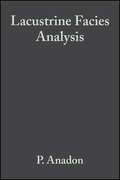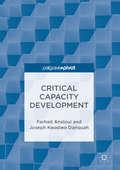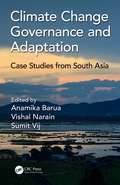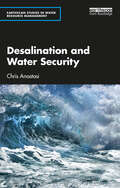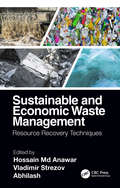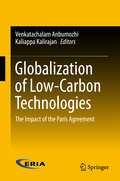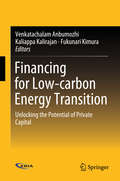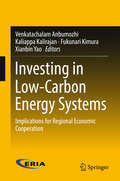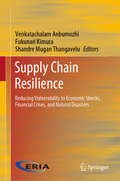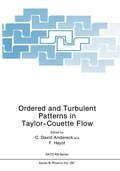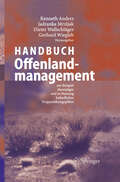- Table View
- List View
Lacustrine Facies Analysis (International Association Of Sedimentologists Series #30)
by P. Anadon L. L. Cabrera K. KeltsThis book considers the deposition of sediments in different types of lakes and shows how changes in the lake environment can be interpreted from the sediment facies at the lake floor. Lakes are particularly sensitive to climate change and thus their sediments are accurate indicators of environmental change and palaeoclimate. This volume examines both ancient and modern lake deposits which is particularly appropriate considering the current widespread interest in global climate change, with particular emphasis on global warming. The book is global in approach and contains fifteen papers from an internationally acclaimed authorship. The volume will be of particular interest to sedimentologists, petroleum geologists, economic geologists and geographers with a particular interest in global climate change
Critical Capacity Development
by Farhad Analoui Joseph Kwadwo DanquahThis book contributes to our understanding of a neglected and poorly-understood concept within the development field: ‘capacity development’ in the context of human and organisational sustainable development. Relating ‘capacity development’ to other perspectives in development thinking and practice and giving an account of the concept’s genesis, the book introduces readers to recent empirical research initiatives that help to elucidate the concepts of capacity, capacity development, and capacity management. While capacity development initiatives and programmes have been used by most international and national agencies over the course of the last five decades, the term means different things to different people and especially to different major players in the international community. This weakens its effectiveness. This book therefore strives first of all to set ground rules that can be utilised by international aid providers such as UNDP, OECD, World Bank, and CIDA and practitioners alike.
Critical Capacity Development
by Farhad Analoui Joseph Kwadwo DanquahThis book contributes to our understanding of a neglected and poorly-understood concept within the development field: ‘capacity development’ in the context of human and organisational sustainable development. Relating ‘capacity development’ to other perspectives in development thinking and practice and giving an account of the concept’s genesis, the book introduces readers to recent empirical research initiatives that help to elucidate the concepts of capacity, capacity development, and capacity management. While capacity development initiatives and programmes have been used by most international and national agencies over the course of the last five decades, the term means different things to different people and especially to different major players in the international community. This weakens its effectiveness. This book therefore strives first of all to set ground rules that can be utilised by international aid providers such as UNDP, OECD, World Bank, and CIDA and practitioners alike.
Climate Change Governance and Adaptation: Case Studies from South Asia
by Anamika Barua, Vishal Narain and Sumit VijClimate change adaptation in South Asia is redefining the roles of different actors in the governance processes. The existing governance lack capacity, knowledge, and leadership skills to manage the uncertainties and challenges posed by climate change. This book aims to explain how the governance of climate change adaptation and mitigation is being shaped in the region and how climate change is impacting upon the governance of natural resources. Although the focus is on South Asia, the editors draw a wide range of contributions from northern and southern communities and across various agro-ecological contexts. Climate Change Governance and Adaptation: Case Studies from South Asia sees the changing climate not only as an environmental problem but as a societal challenge and discusses the governance challenges from an interdisciplinary social science perspective across different levels: local, state, and national. Discusses also the challenges and opportunities for increasing the resilience of the society through effective governance around climate change. A top down approach to govern climate change adaptation may not yield desired outcomes; instead the book emphasizes the need to integrate issues of equity, into climate governance and polices. The lessons learned from different cases across South Asia help readers have a better and deeper understanding of the relationships between governance and climate change. Given the diversity of themes covered, this book will appeal not only to researchers and practitioners in the climate change community, but also to those with a broader interest in governance processes.
Microbial Biocontrol Agents: Developing Effective Biopesticides
by Abhishek Anand Marc Bardin Ana Bejarano Elisa Bona Tito Caffi Hamza Chammem Antonieta De Cal Margherita Furiosi Elisa Gamalero Bernard R. Glick Belén Guijarro Lars Huber Dr Ajay Kumar Inmaculada Larena Sara E. Legler Carla S. Lorenz Paloma Melgarejo Hassan Momeni Fahimeh Nazari Andrea Nesler Philippe Nicot Ma. del Orozco-Mosquedab Ilaria Pertot Thomas Pressecq Dr Gerardo Puopolo Vittorio Rossi Naser Safaie Gustavo Santoyo Selena Tomada Estelle Turc Maria Villarino Mout De Vrieze Laure WeisskopfThe negative impact of chemical pesticides on human wellbeing and the environment has encouraged the development of eco-friendly alternatives for the management of plant pathogens. However, only a small number of microbial biocontrol agents (mBCAs) have been developed, registered and used in the management of plant diseases. This book analyses the deployment of mBCAs for the development of novel microbial biopesticides, considering the main plant-beneficial traits, procedures needed for effective formulations and the processes used for their validation. To guide the readers through the world of microbial biopesticides, the book starts with a chapter dedicated to the regulations that need to be followed for the development of final products. Readers will understand the importance of formulation and mode of action of mBCAs in developing microbial biopesticides. They will become familiar with key mBCAs such as Ampelomyces quisqualis, Bacillus spp., Trichoderma spp., and Pseudomonas spp., understanding the importance of formulation for their application in the field. This book explains the use of mBCAs to control post-harvest diseases and the potential of endophytic microorganisms as next-generation microbial biopesticides. A final chapter provides a useful workflow for the selection of new mBCAs and describes microbial species including promising mBCAs that might be developed as new microbial biopesticides. - Gives useful insights into the practicalities of regulation of mBCAs - Describes the underlying biology that it is critical to developing mBCAs - Provides case studies for key mBCA species - Indicates microbial species exploitable for the development of new microbial biopesticides For students and researchers involved in crop protection and biological control
Sustainable Development Goals in Northeast India: Challenges and Achievements (Advances in Geographical and Environmental Sciences)
by Subhash Anand Madhushree Das Rituparna Bhattacharyya R. B. SinghThis book covers themes related to the geosphere, biosphere, sociosphere and ecosphere dealing with changing geographical, environmental and socio-economic realities to plan a sustainable future for the northeast region (NER) of India. The NER consists of eight states—Assam, Arunachal Pradesh, Tripura, Nagaland, Manipur, Mizoram, Meghalaya and Sikkim—and they carry political, economic and social importance. The book integrates the past, present and future of geospheric attributes incorporating progress towards the Sustainable Development Goals (SDGs) to meet the demands for improving human wellbeing under diverse and challenging socio-economic, political and environmental conditions. The key SDGs, as in food and agriculture, health, education, water, energy and other overarching goals of the region, have yet to incorporate providing sustainable jobs and promoting equality and inclusive development, although there have been a few studies in that regard.The challenges to achieve SDGs in the NER are formidable compared to the rest of India. The NER has put a great deal of effort into achieving the SDGs, mainly in poverty (SDG-1), good health (SDG-3), education (SDG-4), gender (SDG-5), decent work (SDG-8) and reduced inequalities (SDG-10), similar to the rest of the country. However, the standard development indicators such as road length, access to health care, power consumption and other measures are far below the national average. A multi-pronged strategy has played a pivotal role in the region, but development strategy to attain the SDGs 2030 must be more inclusive in empowering people with maximising self-governance, considering the resources, needs and aspirations of the people.This book evaluates the performance of the SDGs and fills in the gaps. It includes case studies focusing on different SDGs using advanced cartographic, statistical and GIS techniques and methods. It also provides unique findings that serve as valuable resources for planners and policy-makers so that a sustainable future in Northeast India can be achieved.
Desalination and Water Security (Earthscan Studies in Water Resource Management)
by Chris AnastasiDesalination is to the water industry what renewables are to the electricity sector. However, unlike renewables, the former is being deployed in a quiet revolution away from public glare. This book provides a holistic view of desalination, highlighting the important role this technology can play in providing safe access to water across the globe. It describes the context for this technology to flourish in the coming decades. It discusses the pressures on freshwater resources and the key role the desalination industry plays as it moves from a good-to-have provider today to a must-have mainstream water solution in the future. The book explores the vital elements of the desalination industry, including the winning technologies and how further technological developments will reduce costs and increase deployment into new areas. It also addresses the energy used and the key environmental issues of carbon dioxide emissions and brine waste production. Using a series of country case studies, the book illustrates how desalination can supplement natural water resources in different environments and for different purposes, and how it is supporting domestic and economic activity. Providing a forward-thinking assessment, the book considers developments over the next 30 years as climate change impacts become even more apparent. This book will be of great interest to those working to alleviate water scarcity and improve water security. It will also be of interest to those in water resource management, water policy and regulation, water science, and environmental engineering.
Desalination and Water Security (Earthscan Studies in Water Resource Management)
by Chris AnastasiDesalination is to the water industry what renewables are to the electricity sector. However, unlike renewables, the former is being deployed in a quiet revolution away from public glare. This book provides a holistic view of desalination, highlighting the important role this technology can play in providing safe access to water across the globe. It describes the context for this technology to flourish in the coming decades. It discusses the pressures on freshwater resources and the key role the desalination industry plays as it moves from a good-to-have provider today to a must-have mainstream water solution in the future. The book explores the vital elements of the desalination industry, including the winning technologies and how further technological developments will reduce costs and increase deployment into new areas. It also addresses the energy used and the key environmental issues of carbon dioxide emissions and brine waste production. Using a series of country case studies, the book illustrates how desalination can supplement natural water resources in different environments and for different purposes, and how it is supporting domestic and economic activity. Providing a forward-thinking assessment, the book considers developments over the next 30 years as climate change impacts become even more apparent. This book will be of great interest to those working to alleviate water scarcity and improve water security. It will also be of interest to those in water resource management, water policy and regulation, water science, and environmental engineering.
Finsler and Lagrange Geometries: Proceedings of a Conference held on August 26–31, Iaşi, Romania
by Mihai Anastasiei P. L. AntonelliIn the last decade several international conferences on Finsler, Lagrange and Hamilton geometries were organized in Bra§ov, Romania (1994), Seattle, USA (1995), Edmonton, Canada (1998), besides the Seminars that periodically are held in Japan and Romania. All these meetings produced important progress in the field and brought forth the appearance of some reference volumes. Along this line, a new International Conference on Finsler and Lagrange Geometry took place August 26-31,2001 at the "Al.I.Cuza" University in Ia§i, Romania. This Conference was organized in the framework of a Memorandum of Un derstanding (1994-2004) between the "Al.I.Cuza" University in Ia§i, Romania and the University of Alberta in Edmonton, Canada. It was especially dedicated to Prof. Dr. Peter Louis Antonelli, the liaison officer in the Memorandum, an untired promoter of Finsler, Lagrange and Hamilton geometries, very close to the Romanian School of Geometry led by Prof. Dr. Radu Miron. The dedica tion wished to mark also the 60th birthday of Prof. Dr. Peter Louis Antonelli. With this occasion a Diploma was given to Professor Dr. Peter Louis Antonelli conferring the title of Honorary Professor granted to him by the Senate of the oldest Romanian University (140 years), the "Al.I.Cuza" University, Ia§i, Roma nia. There were almost fifty participants from Egypt, Greece, Hungary, Japan, Romania, USA. There were scheduled 45 minutes lectures as well as short communications.
Sustainable and Economic Waste Management: Resource Recovery Techniques
by Hossain Anawar Vladimir Strezov AbhilashThis book compiles research findings directly related to sustainable and economic waste management and resource recovery. Mining wastes and municipal, urban, domestic, industrial and agricultural wastes and effluents—which contain persistent organic contaminants, nanoparticle organic chemicals, nutrients, energy, organic materials, heavy metal, rare earth elements, iron, steel, bauxite, coal and other valuable materials—are significantly responsible for environmental contamination. These low-tenor raw materials, if recycled, can significantly address the demand–supply chain mismatch and process sustainability as a whole while simultaneously decreasing their impacts on human life and biodiversity. This book summarises the large volume of current research in the realm of waste management and resource recovery, which has led to innovation and commercialisation of sustainable and economic waste management for improved environmental safety and improved economics. Key Features: Reviews the key research findings related to sustainable and economic resource recovery and waste management techniques Discusses minimizing waste materials and environmental contaminants with a focus on recovering valuable resources from wastes Examines the potential uses of mining waste in the re-extraction of metals, provision of fuel for power plants, and as a supply of other valuable materials for utilisation/processing Presents research on recycling of municipal, urban, domestic, industrial and agricultural wastes and wastewater in the production and recovery of energy, biogas, fertilizers, organic materials and nutrients Outlines topical research interests resulting in patents and inventions for sustainable and economic waste management techniques and environmental safety
Sustainable and Economic Waste Management: Resource Recovery Techniques
by Hossain Anawar Vladimir Strezov AbhilashThis book compiles research findings directly related to sustainable and economic waste management and resource recovery. Mining wastes and municipal, urban, domestic, industrial and agricultural wastes and effluents—which contain persistent organic contaminants, nanoparticle organic chemicals, nutrients, energy, organic materials, heavy metal, rare earth elements, iron, steel, bauxite, coal and other valuable materials—are significantly responsible for environmental contamination. These low-tenor raw materials, if recycled, can significantly address the demand–supply chain mismatch and process sustainability as a whole while simultaneously decreasing their impacts on human life and biodiversity. This book summarises the large volume of current research in the realm of waste management and resource recovery, which has led to innovation and commercialisation of sustainable and economic waste management for improved environmental safety and improved economics. Key Features: Reviews the key research findings related to sustainable and economic resource recovery and waste management techniques Discusses minimizing waste materials and environmental contaminants with a focus on recovering valuable resources from wastes Examines the potential uses of mining waste in the re-extraction of metals, provision of fuel for power plants, and as a supply of other valuable materials for utilisation/processing Presents research on recycling of municipal, urban, domestic, industrial and agricultural wastes and wastewater in the production and recovery of energy, biogas, fertilizers, organic materials and nutrients Outlines topical research interests resulting in patents and inventions for sustainable and economic waste management techniques and environmental safety
Globalization of Low-Carbon Technologies: The Impact of the Paris Agreement
by Venkatachalam Anbumozhi Kaliappa KalirajanThis book explores the opportunities and barriers within the Intended Nationally Determined Contributions (INDC) framework of the Paris Agreement for low-carbon technology diffusion. Further, it proposes appropriate and feasible mechanisms required at local, national and regional levels to achieve the INDC targets. The book employs both meta policy analysis and scenario building to examine, whether the diffusion of low-carbon energy future by 2030 is economically viable under the INDC framework and how international technology cooperation could accelerate investments on the scale required for achieving the INDC targets.Further, this book provides new perspectives on market and non-market mechanisms for the globalization of low-carbon technologies, within the framework conditions of the Paris Agreement, which will be of significant value to senior policy makers, multi-disciplinary academia, and investing communities.
Financing for Low-carbon Energy Transition: Unlocking the Potential of Private Capital
by Venkatachalam Anbumozhi Kaliappa Kalirajan Fukunari KimuraThis book is the first comprehensive assessment of the state of low-carbon investments in Asia, analyzing the rationales, mandates and public–private financing activities. Based on the experiences of several regional initiatives wherein public financing is catalyzing private investments in low-carbon infrastructure, this book proposes a framework that can be used as a tool to identify factors that influence private investment decisions and policy instruments that can scale up the private capital.Placing the Asian economies onto a low-carbon development pathway requires an unprecedented shift in investments. This book addresses this situation by asking questions such as: • What is the central role of private finance in achieving the Paris Agreement targets? • What key policy levers and risk mitigation can governments use in an effort to unlock the potentials of private capital? • How can regionally coordinated actions hold significant promise for scaling up private investments?
Sustainable Development Goals and Pandemic Planning: Role of Efficiency Based Regional Approaches
by Venkatachalam Anbumozhi Kaliappa Kalirajan Fukunari KimuraThis book assesses the progress in the implementation of Sustainable Development Goals (SDGs) in ASEAN, India and China using the above framework conditions in the context with three main propositions. First, translating the SDGs into regional economic integration strategies during the pandemic recovery can enhance the link between global objectives and the multifaceted reality of an ASEAN community building process, and providing a strategic option to strengthen the regional approaches. Secondly, a regional approach on complementarities to SDGs can facilitate the definition of relevant targets/indicators and enhance the monitoring and evaluation framework. In so doing it could also offer the scope to integrate more closely ASEAN community’s social and environmental concerns into existing economic, social and political frameworks. Thirdly, focusing just on the geo-economic sphere – the area where south east and East Asian economic integration is relatively more advanced – will prove the hypothesis that effective regional integration through mega trade agreements such as the Regional Comprehensive Economic Partnership (RCEP) can support the Asia’s transformation agenda and foster more inclusive and sustainable growth.
Investing in Low-Carbon Energy Systems: Implications for Regional Economic Cooperation
by Venkatachalam Anbumozhi Kaliappa Kalirajan Fukunari Kimura Xianbin YaoThis book focuses on multi-level actions that have attracted considerable interest and discussion within academia, decision makers and the public as a tool to assess anthropogenic effects of low-carbon energy development. The book begins with an overview of the state of the art policies in emerging economies, which provides a starting point for understanding the concept of low-carbon green growth. A unified framework for structuring, categorizing, and integrating various regional-level actions is established on the basis of a thorough investigation into the theoretical and methodological aspects of non-conventional energy policies that have been widely adopted. Furthermore, the book brings clarity to the relationship between clean energy policies and stakeholder participation, and the significance of coordinated actions at the regional level. The findings provide novel insights and policy tools to help decision-makers in identifying ways to mobilize private investment in low-carbon energy systems.
Supply Chain Resilience: Reducing Vulnerability to Economic Shocks, Financial Crises, and Natural Disasters
by Venkatachalam Anbumozhi Fukunari Kimura Shandre Mugan ThangaveluThis book investigates individual companies’ and industries’ supply chain risk management approaches to identify risk drivers and verify effective risk-reduction measures and business continuity plans.Typically, supply chain risk assessments focus on normative guidelines based on single best practice examples or vulnerability events, and there has been little work exploring how the concepts of supply chain risk management and resilience are related. However, since this relationship has implications for developing integrated response strategies, a clear understanding of the possible consequences is a fundamental step in building socio-economic resilience along the supply chain.Against this background, the book addresses three main topics: firstly, it defines the conceptual and sectoral domains of supply chain risk management and resilience by examining the welfare effects of extreme weather events and other economic shocks on selected global supply chains. It then presents an in-depth analysis of the scope of public–private partnerships to tackle the risks, by empirically exploring supply chain risk effects and information management. Thirdly, it proposes a regional cooperation framework in the context of major supply chain vulnerability events such as disasters and global financial crises.
Democracy Disconnected: Participation and Governance in a City of the South (Routledge Studies in Urbanism and the City)
by Fiona Anciano Laurence PiperWhy is dissatisfaction with local democracy endemic, despite the spread of new participatory institutions? This book argues that a key reason is the limited power of elected local officials, especially to produce the City. City Hall lacks control over key aspects of city decision-making, especially under conditions of economic globalisation and rapid urbanisation in the urban South. Demonstrated through case studies of daily politics in Hout Bay, Democracy Disconnected shows how Cape Town residents engage local rule. In the absence of democratic control, urban rule in the Global South becomes a complex and contingent framework of multiple and multilevel forms of urban governance (FUG) that involve City Hall, but are not directed by it. Bureaucratic governance coexists alongside market, developmental and informal forms of governance. This disconnect of democracy from urban governance segregates people spatially, socially, but also politically. Thus, while the residents of Hout Bay may live next to each other, they do not live with each other. This book will be a valuable resource for students on programmes such as urban studies, political science, sociology, development studies, and political geography.
Democracy Disconnected: Participation and Governance in a City of the South (Routledge Studies in Urbanism and the City)
by Fiona Anciano Laurence PiperWhy is dissatisfaction with local democracy endemic, despite the spread of new participatory institutions? This book argues that a key reason is the limited power of elected local officials, especially to produce the City. City Hall lacks control over key aspects of city decision-making, especially under conditions of economic globalisation and rapid urbanisation in the urban South. Demonstrated through case studies of daily politics in Hout Bay, Democracy Disconnected shows how Cape Town residents engage local rule. In the absence of democratic control, urban rule in the Global South becomes a complex and contingent framework of multiple and multilevel forms of urban governance (FUG) that involve City Hall, but are not directed by it. Bureaucratic governance coexists alongside market, developmental and informal forms of governance. This disconnect of democracy from urban governance segregates people spatially, socially, but also politically. Thus, while the residents of Hout Bay may live next to each other, they do not live with each other. This book will be a valuable resource for students on programmes such as urban studies, political science, sociology, development studies, and political geography.
Political Values and Narratives of Resistance: Social Justice and the Fractured Promises of Post-colonial States (Routledge Research on Decoloniality and New Postcolonialisms)
by Fiona Anciano Joanna WheelerThis book brings together multidisciplinary perspectives to explore how political values and acts of resistance impact the delivery of social justice in post-colonial states. Everyday life in post-colonial states, such as South Africa and Zimbabwe, is characterized by injustices that have both a historical and contemporary nature. From fishers in Cape Town accused of poaching, to residents of Bulawayo demanding access to water, this book focuses on the relationship between the state and groups that have been historically oppressed due to being on the margins of the political, economic and social system. It draws on empirical research from 12 scholars looking at cases in Brazil, India, South Africa and Zimbabwe. Chapters explore questions such as what citizens, especially those from marginalized groups, want from the state. The book looks at the political values of citizens and how these are formed in the process of engaging with the state and through everyday injustices. It also asks why and how citizens resist the state, with examples of protest, as well as less visible forms of resistance reflecting complex histories and power relations. Finally, the book explores how narratives and counter-narratives reveal the nature of political values and perceptions of what is just. Taken together these elements show the evolution of post-colonial social contracts. Examining important themes in political science, anthropology, sociology and urban geography, this book will appeal to scholars and students interested in political values, justice, social movements and resistance.
Mathematical Paradigms of Climate Science (Springer INdAM Series #15)
by Fabio Ancona Piermarco Cannarsa Christopher Jones Alessandro PortaluriThis book, featuring a truly interdisciplinary approach, provides an overview of cutting-edge mathematical theories and techniques that promise to play a central role in climate science. It brings together some of the most interesting overview lectures given by the invited speakers at an important workshop held in Rome in 2013 as a part of MPE2013 (“Mathematics of Planet Earth 2013”). The aim of the workshop was to foster the interaction between climate scientists and mathematicians active in various fields linked to climate sciences, such as dynamical systems, partial differential equations, control theory, stochastic systems, and numerical analysis. Mathematics and statistics already play a central role in this area. Likewise, computer science must have a say in the efforts to simulate the Earth’s environment on the unprecedented scale of petabytes. In the context of such complexity, new mathematical tools are needed to organize and simplify the approach. The growing importance of data assimilation techniques for climate modeling is amply illustrated in this volume, which also identifies important future challenges.
Sense: Plurilocal Self-Location and Emotional Geographies through the Lens of International Migration (BestMasters)
by Jessica AndelThe German notion of ‘Heimat’ is highly subjective, ambiguous and historically charged. Senses of belonging and identity associated with Heimat render the concept vulnerable to appropriation and instrumentalization by different political forces. Thereby, a static and exclusive understanding of Heimat is often depicted. This book drafts a counternarrative to demystify the contested concept. On the one hand, Heimat is conceptualized as spatial through emotional-geographical approaches to human-place relations. And on the other hand, the concept is placed in a global context through the perspective of international migration. The author contributes to the understanding of Heimat as an emotional map of self-location. This subjective map is neither purely static nor dynamic - it is characterized by simultaneities of opposing processes.
Ordered and Turbulent Patterns in Taylor-Couette Flow (Nato Science Series B: #297)
by C. David Andereck F. HayotSeldom does a physical system, particularly one as apparently simple as the flow of a Newtonian fluid between concentric rotating cylinders, retain the interest of scientists, applied mathematicians and engineers for very long. Yet, as this volume goes to press it has been nearly 70 years since G. I. Taylor's outstanding experimental and theoretical study of the linear stability of this flow was published, and a century since the first experiments were performed on rotating cylinder viscometers. Since then, the study of this system has progressed enormously, but new features of the flow patterns are still being uncovered. Interesting variations on the basic system abound. Connections with open flows are being made. More complex fluids are used in some experiments. The vigor of the research going on in this particular example of nonequilibrium systems was very apparent at the NATO Advanced Research Workshop on "Ordered and Turbulent Patterns in Taylor Couette Flow," held in Columbus, Ohio, USA May 22-24, 1991. A primary goal of this ARW was to bring together those interested in pattern formation in the classic Taylor Couette problem with those looking at variations on the basic system and with those interested in related systems, in order to better define the interesting areas for the future, the open questions, and the features common (and not common) to closed and open systems. This volume contains many of the contributions presented during the workshop.
Innovations in Land, Water and Energy for Vietnam’s Sustainable Development (UNIPA Springer Series)
by Mariano AnderleThis book presents recent innovative trends in land, water and energy management in Vietnam. Presenting the main projects and outcomes of a close collaboration between Italian and Vietnamese researchers in the last three years, the book is divided into three main sections: environment, climate change and land management in Vietnam; energy for Vietnam; and cities and utilities in Vietnam. The first section focuses on water systems, including rivers and seacoasts, and on new growing methods for more sustainable agriculture. The second section addresses energy and wastewater. The country’s rapid growth is a major challenge in terms of reinforcing the electrical infrastructures, and as such this section offers an overview of the government’s planned measures and their impact on the Vietnamese power system. The third section highlights cities and utilities in the context of increasing urbanization, exploring the urban morphology of the Vietnamese metropolis, particularly Hanoi and Ho Chi Minh City.
Handbuch Offenlandmanagement: Am Beispiel ehemaliger und in Nutzung befindlicher Truppenübungsplätze
by Kenneth Anders Jadranka Mrzljak Dieter Wallschläger Gerhard WieglebDas Handbuch Offenlandmanagement bietet Grundlagen und Konzepte, mit deren Hilfe wertvolle Offenlandschaften in der Kulturlandschaft Mitteleuropas erhalten, gestaltet und entwickelt werden können. Stillgelegte Truppenübungsplätze bieten so Lebensraum für selten gewordene und speziell angepasste Tiere und Pflanzen. Die verschiedenen Managementverfahren zur Biotoppflege werden vergleichend bewertet und im Hinblick auf ihre naturschutzfachliche Wirkung, ihre ökonomische Effektivität und ihre umweltsoziologische Akzeptanz diskutiert. Besonderer Wert wird auf innovative Verfahren gelegt. Sechs Untersuchungsgebiete sind für das Buch porträtiert und in handlungsorientierten Entwicklungsszenarien dargestellt worden. Das Buch ist in verständlicher Sprache gehalten und wendet sich neben Wissenschaftlern auch an Praktiker aus Naturschutz, Forst und Verwaltung. Die Ergebnisse dieses dreijährigen BMBF-Verbundprojekts sind auf eine hohe Übertragbarkeit hin ausgewertet worden. Zahlreiche Farbfotos illustrieren die landschaftliche Eigenart der Offenflächen.
Fire in Tropical Savannas: The Kapalga Experiment (Ecological Studies #169)
by Alan N. Andersen Garry D. Cook Richard J. WilliamsFire is a major agent of disturbance in many biomes of the world but is a particularly important feature of tropical savannas. Up to 50% of the ext- sive tropical savanna landscapes of northern Australia are burnt each year. This includes prestigious conservation reserves such as World Heritage— listed Kakadu National Park, in the Top End of the Northern Territory. As in other savanna regions of the world, the responses of biota to different ?re regimes are poorly understood, such that ?re management represents one of the greatest challenges to conservation managers and researchers alike. This is the context within which a landscape-scale ?re experiment was established at Kapalga Research Station in Kakadu,which aimed to provide a sound scienti?c basis for conservation management in the region. The experiment was established by The Australian Commonwealth Scienti?c and Industrial Research Organization (CSIRO),but involved collaborators from a range of universities and government agencies, including the m- agers of Kakadu,the Australian Nature Conservation Agency (ANCA:now Parks Australia North). This book summarizes the ?ndings from the Kapalga ?re experiment and explores the implications for conservation management. We believe that Kapalga has provided important insights into the ?re ecology of tropical savannas and has broad relevance for the conservation management of ?- prone landscapes in general. This book should be of interest to researchers, graduate students, and land management agencies. vii viii Preface We are extremely grateful to all our collaborators,both inside and outside CSIRO, for their involvement in the Kapalga experiment.
